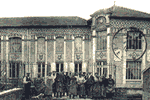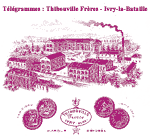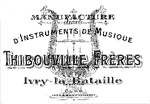History
This place’s history is also that of its founder: Nicolas Eugène Thibouville
Nicolas Eugène Thibouville
Eugene Thibouville was born on February 12 1823 in La Couture-Boussey (Eure), the son of Martin Thibouville (1793-1873), instrument maker established in La Couture-Boussey and of Marie Marguerite Bousselaire (2)
With his father and brother Martin Denis, they created a partnership under the business name “Martin Thibouville Aîné, 67 rue des vieux Augustin” in Paris. Martin Thibouville already owned a factory in La Couture since 1820, before coming to Paris a little before 1848 (1). Like many craftsmen from La Couture, they decided to try their luck in Paris. The father, Martin and his two sons Martin Denis and Eugene Nicolas used their house of La Couture-Boussey as well as a shop located in 67 rue des Vieux Augustin in Paris. It appears likely that Eugene, who was living in Paris, was running the shop while his father and brother Martin Denis stayed behind in La Couture to make the ordered instruments.
Towards 1850
As stated on the receipts and letters, their home was « supplier for the communal military gymnasium / in virtue of the superiority obtained on the last competition of 31 March 1851 ». It is also stated that they hold « an honorable mention at the first Exposition of industrial products of 1849”.
In 1852,Eugene married Catherine Pulcherie Huan under the regime of the community. From this union Adrien (1856†1922) and Camille (1864†xxxx) were born.

The partnership between father and sons took an abrupt halt in the early 50’s. After he sues the company, Nicolas Eugene stays alone at 67 rue des Vieux Augustin in Paris (3). This lead to a monumental quarrel: the father and his eldest son Martin Denis kept the workshop in La Couture and opened a new shop in Paris, two doors away from the old one, which ruined Nicolas’ plans. The father sends letters to all his customers claiming that he drove his youngest son away from Paris due to his misbehaviour and lack of diligence in managing the business, that with the help of his eldest he is taking charge of the company, and lastly forbids anyone to give Eugene another penny. All the company’s receipts are sent to the siege in Paris from here on. After the trial and liquidation by the Commercial Court, M. Dubrut is designated as liquidator. Eugene Thibouville opposes the liquidation and is chased from the La Couture-Boussey society on the day of the inventory. He also objects that the estimated value of the business is only a fifth of its actual worth. His business ventures were most likely unsuccessful. In 1855 Eugene leaves Paris for Ivry-la-Bataille (1). Probably starting from 11 November 1858, a penny-less Eugene partners with his friend from La Couture-Boussey, Noblet Jeune. Though fruitful this partnership was short-lived. While quite a number of instruments are still remaining today, their society NOBLET ET THIBOUVILLE/ A IVRY-LA-BATAILLE did no longer exist as of 1874 (3).
Nobody knows for certain where and when he was active, still, the former premises of the abbey served as a comb and music instruments workshop until it was destroyed in a fire the night of 23 April 1869 (4). Eugene Thibouville was certainly among the victims. He is found again in the abbey’s factory in an unsigned lease from May 1878 where he commits to rent to Emile Laporte, his future son-in-law.

Lease including:
1. A workshop of approximately 91 by 29 feet with an attic above, located on the first floor
2. Permission to place in this workshop eight towers for the instruments, a bandsaw and a small circular saw to cut wood fit for manufacturing.

This lease includes extremely thorough recommendations on the transmissions and the use of hydraulic force, very in demand at the time. There is an old photograph from the end of the 19th century of the door to the abbey, and above it, a board with the following inscription: “Eugene THIBOUVILLE windpipe instruments factory”. The adjoining house bears on each chimney a big letter molted in iron, an E and a T. Eugene Thibouville may have bought this house after Mr. Laporte passed away.
In 1871 he was also sub-renting in the factory of the abbey’s mill. Towards 1889 Eugene joined forces with his sons, Adrien (1856†1922) and Camille (1864†xxxx) for his company under the business name: The Sons of Eugene Thibouville (3). It appears no instruments were ever made under this brand but still under the father’s signature: (EUGENE THIBOUVILLE / A IVRY LA BATAILLE). On February 8 1887 it is told through letters and bills that Eugene Thibouville is in business with Hubart Persin from Paris, ordering brass instruments, cornets, trombones and altos from him (3).
After Eugene Thibouville’s death
Eugene dies on 3 December 1891 in Ivry-la-Bataille. His two sons Adrien and Camille continue to run the company under their late father’s name. On 30 July 1898 as stated by an act from Maître Maucuit, notary in Ivry-la-Bataille, Adrien Thibouviller and his wife acquire a big property in Irvy-la-Bataille which belonged to Mr. Duval, a manufacturer of ivory combs, including two neighboring factories:
1. Usine du Moulin l’Abbé
2. Usine de la Portelle.
Both these factories were build on small islands of the river Eure, each having their own water wheel, they used to serve for the making of flour and leather before becoming comb workshops and finally instrument workshops (5).
Following these acquisitions the family decides to modernize the facilities, make the buildings in la Portelle bigger and develop their activity. In the 1900 catalog a great variety of instruments are on display as well as the “Famous Besson instruments”. Under this brand the whole array of brass is sold as well as the cornophone (brevet Besson 1890) (6).
On 1 September 1909, in a promotional letter Camille states that he is leaving the partnership to settle in rue de la Porte à Bateaux in Ivry-la-Bataille, he was indeed the owner of a vast house in this street, which afterwards will become the tax office of Ivry-la-Bataille. Although rivalling his brother for some time with the manufacturing and selling of the same type of instruments, he does not seem to have had a very important business, nor very durable, as known instruments from him are quite few (3). His brand was : CAMILLE THIBOUVILLE / IVRY-LA-BATAILLE

With his two sons Eugene (1884 †1915 in Souchez, Pas de calais ) and George (17 janvier 1886† 6 septembre 1957 in Ivry-la-Bataille)(5)
New brand: THIBOUVILLE / Frères / IVRY (EURE). After Eugene II dies in battle in Souchez (Pas de Calais) on May 26 1915, George continues to make instruments with the help of his father. In 1919, facing difficult times, they decide to sell the factory of the Mill Abbey to Mr. Martel, a comb maker. These buildings will eventually be acquired by SOLIDO (miniature cars manufacturer) until 1983.
The Thibouville instruments
During that era, metal clarinets were made for some years including signature models like Adrien Thibouville and more Thibouville Frères à Ivry-la-Bataille. Adrien Thibouville suddenly died after a party in Ivry-la-Bataille on June 9 1923 during which the factory instruments were on display in a glass case probably made especially for the occasion (quote from Mr. Lemaire). The company ceased all activities during the war and closed in 1940. In 1947, George Thibouville, the only heir, partnered with Maurice Masson (La Couture-Boussey 29 April 1908-Ivry-la-Bataille, June 1992). The latter was mayor of Ivry-la-Bataille from November 1947 until 1977, the son of an instrument maker from La Couture-Boussey, Clément Masson, who himself had succeeded Mr. Djalma Julliot who had made a name for himself in the early 20th century with his transverse flutes.

From this time on house Thibouville specialises in Boehm system clarinets in all different tones: E, B, C, A, alto flute, bass flute, most of which were then shipped to the USA. The brand did not change, even after George passed in 1957. With the latter’s descendents, Maurice Masson kept on making instruments. Under the name Thibouville frères, but also under the brand M Masson/Paris, special systems are made and build, including one for the Mc Intyre system subcontracted by an American customer. Based on the prototypes that were found, the latter was probably made in different tones: E, B, C, A, alto and bass. This system revolutionized the upper joint of the clarinet by getting rid of the C-clef and the G-sharp which were replaced by a specific use of the rings
Note that a large number of these clarinets were made in B flat, but did not seem to have quite the success that was expected, part of this order was never paid, nor completed. The lower joint and the tube were identical to the common clarinets, they were reused to make other instruments.
In the early 70’s, with the bad economic situation and the foreign competition increasingly present, the company was no longer profitable. Mr. Masson and the last two descendents of the Thibouville family with no heir, decided to sell.
On June 1st 1974 , the buildings were conceded to Couesnon, a big house specialized in the making of instruments established in Paris, Chateau-Thierry. They only used the La Portelle factory for a very short time. All activities ceased towards the end of the 70’s. After all the stock was liquidated and most of the tools were moved to Château-Thierry, the buildings were again sold on January 10 1981.
Since that time, no instruments were made in this place. Instruments with the Thibouville brand are now a legacy of the past. Throughout the 17th century there are traces of Bouville, Ti Bouville, Tibouvile, Thibouville…

Depending on the person who came to report at the church register, most of the time the town abbot. I traced the first spelling of Thibouville as such back to a 1699 register, this spelling was only definitively adopted on the instruments in the early 19th century. These different manufacturers, although their name sometimes have different spellings, are from the same line of craftsmen in La Couture-Boussey (Eure). Sometimes they migrated to neighbouring towns, got married, partnered, and sometimes quarreled.

All these factors provide us with an amazing variety of brands used by these manufacturers. To this day I have listed 41 different brands. Rather than reproduce them to their identical, I saved some time by simplifying them using a different style, for the ones in italic and capitals. These different brands were all found in private collections. This list of course is not exhaustive.
(1) Constant PIERRE Les facteurs d’instruments de musique pages 324/326
(2) Etat civil La Couture-Boussey
(3) Lettres et catalogues (coll: Thibouville / Camboulive)
(4) Article de M Jean Pierre SUAU (NOUVELLES DE L’EURE N°49, page 49 {ses sources: le courrier de l’Eure du 27 avril 1869}).
(5) Inventaire après décès Adrien THIBOUVILLE / DEBAIS
(6) Catalogue 1900 LES FILS D’ EUGENE THIBOUVILLE, pages 16, 17 et 18
(7) Cliché original. (coll: Lemaire Ivry la Bataille)
(8) Brouillon de la main d’Eugène Thibouville et livre de compte de la société
Noblet ; Thibouville (coll: Thibouville / Camboulive)
François Camboulive IVRY LA BATAILLE 30sept 2001
1er version éditée dans le LARIGOT n° 17 pages 8 et 9 en août 1995

